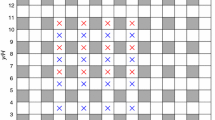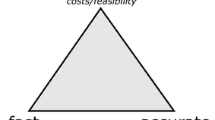Abstract
The propagation of a pollutant emitted from localized sources both within and above a regular street network is studied by analyzing data from direct numerical simulations of passive scalar dispersion. Two wind directions are considered, corresponding to aligned and oblique flow with respect to the street axes. Particular attention is paid to the role of entrainment of the scalar into the urban canopy from an elevated source and re-entrainment of material originally released further upstream from a ground source. The variation of concentration differences and vertical fluxes between the streets and the air above as a function of distance reveals important differences between the rate of lateral and vertical mixing for the two sources. Detrainment and entrainment need a longer fetch to equilibrate for the elevated source than for the ground source. There are large differences between the advection and detrainment velocities for the aligned and oblique cases, so that a change in wind direction could affect ventilation efficiency considerably. Time scales associated with different dispersion processes are computed and the time of first appearance of the scalar from the onset of release in different streets is mapped. It is shown that re-entrainment can provide a shortcut dispersion pathway for reaching certain parts of the network. This is particularly striking in the case of oblique flow, when material can be transferred by entrainment up to twice as rapidly as by advection. Taken together, these results highlight the overall message that vertical exchange is a two-way process and that entrainment needs to be considered in the context of emergency response as well as urban ventilation.











Similar content being viewed by others
References
Belcher SE, Coceal O, Hunt JCR, Carruthers DJ, Robins AG (2012) A review of urban dispersion modelling. Technical report, Atmospheric Dispersion Modelling Liaison Committee Report
Belcher SE, Coceal O, Goulart EV, Rudd AC, Robins AG (2015) Processes controlling atmospheric dispersion through city centres. J Fluid Mech 763:51–81. https://doi.org/10.1017/jfm.2014.661
Branford S, Coceal O, Thomas TG, Belcher SE (2011) Dispersion of a point-source release of a passive scalar through an urban-like array for different wind directions. Boundary-Layer Meteorol 139(3):367–394. https://doi.org/10.1007/s10546-011-9589-1
Britter RE, Hanna SR (2003) Flow and dispersion in urban areas. Ann Rev Fluid Mech 35(1):469–496. https://doi.org/10.1146/annurev.fluid.35.101101.161147
Carpentieri M, Hayden P, Robins AG (2012) Wind tunnel measurements of pollutant turbulent fluxes in urban intersections. Atmos Environ 46:669–674. https://doi.org/10.1016/j.atmosenv.2011.09.083
Carpentieri M, Robins AG, Hayden P, Santi E (2018) Mean and turbulent mass flux measurements in an idealised street network. Environ Pollut 234:356–367. https://doi.org/10.1016/j.envpol.2017.11.069
Chen L, Hanga J, Sandbergc M, Claessonc L, Sabatinod SD, Wigo H (2017) The impacts of building height variations and building packing densities on flow adjustment and city breathability in idealized urban models. Build Environ 118:344–361. https://doi.org/10.1016/j.buildenv.2017.03.042
Coceal O, Thomas TG, Castro IP, Belcher S (2006) Mean flow and turbulence statistics over groups of urban-like cubical obstacles. Boundary-Layer Meteorol 121(3):491–519. https://doi.org/10.1007/s10546-006-9076-2
Coceal O, Dobre A, Thomas TG, Belcher SE (2007) Structure of turbulent flow over regular arrays of cubical roughness. J Fluid Mech 589:375409. https://doi.org/10.1017/S002211200700794X
Coceal O, Goulart EV, Branford S, Thomas TG, Belcher SE (2014) Flow structure and near-field dispersion in arrays of building-like obstacles. J Wind Eng Ind Aerodyn 125:52–68. https://doi.org/10.1016/j.jweia.2013.11.013
DAPPLE (2011) Final reports to the home office; dapple 2009/13 v3. Technical report
Garbero V, Salizzoni P, Soulhac L (2010) Experimental study of pollutant dispersion within a network of streets. Boundary-Layer Meteorol 136(3):457–487. https://doi.org/10.1007/s10546-010-9511-2
Goulart EV, Coceal O, Belcher SE (2018) Dispersion of a passive scalar within and above an urban street network. Boundary-Layer Meteorol 166(3):351–366. https://doi.org/10.1007/s10546-017-0315-5
Harrison RM (2018) Urban atmospheric chemistry: a very special case for study. Clim Atmos Sci 1(1):2397–3722. https://doi.org/10.1038/s41612-017-0010-8
Hertwig D, Soulhac L, Fuka V, Auerswald T, Carpentieri M, Hayden P, Robins A, Xie ZT, Coceal O (2018) Evaluation of fast atmospheric dispersion models in a regular street network. Environ Fluid Mech 18(4):1007–1044. https://doi.org/10.1007/s10652-018-9587-7
Moin P, Mahesh K (1998) Direct numerical simulation: a tool in turbulence research. Ann Rev Fluid Mech 30(1):539–578. https://doi.org/10.1146/annurev.fluid.30.1.539
Neophytou M, Britter RE (2005) Modelling the wind ow in complex urban topographies: a computational-fluid-dynamics simulation of the central london area. In: Proceedings of the 5th GRACM international congress on computational mechanics, Limassol, Cyprus
Panagiotou I, Neophytou MKA, Hamlyn D, Britter RE (2013) City breathability as quantified by the exchange velocity and its spatial variation in real inhomogeneous urban geometries: An example from central london urban area. Sci Total Environ 442:466–477. https://doi.org/10.1016/j.scitotenv.2012.09.001
Peng Y, Buccolieri R, Gao Z, Ding W (2020) Indices employed for the assessment of urban outdoor ventilation—a review. Atmos Environ 223:955–969. https://doi.org/10.1016/j.atmosenv.2019.117211
Pope SB (2000) Turbulent flows. Cambridge University Press, Cambridge. https://doi.org/10.1017/CBO9780511840531
Shen Z, Cui G, Zhang Z (2017) Turbulent dispersion of pollutants in urban-type canopies understable stratification conditions. Atmos Environ 156:1–14. https://doi.org/10.1016/j.atmosenv.2017.02.017
Soulhac L, Garbero V, Salizzoni P, Mejean P, Perkins R (2009) Flow and dispersion in street intersections. Atmos Environ 43(18):2981–2996. https://doi.org/10.1016/j.atmosenv.2009.02.061
Targa T, Kent A, Stewart R, Coleman P, Bower J, Webster H, Taylor J, Murray V, Mohan R, Aus C (2006) Initial review of air quality aspects of the buncefield oil depot explosion. Technical report, AEA Technology Environment, Netcen
Acknowledgements
Fernanda Cezana, Elisa V. Goulart and Neyval Costa Reis Jnior gratefully acknowledge funding from National Council for Scientific and Technological Development (CNPq), Capes (Coordination of Superior Level Staff Improvement) - Print Institutional Internationalization Program (88881.311735/2018-01.) and Espirito Santo Research Foundation (FAPES), Brazil. Omduth Coceal gratefully acknowledges funding from the Natural Environment Research Council (NERC) through their National Centre for Atmospheric Science (NCAS) under Grant No. R8/H12/83/002 and from the Engineering and Physical Sciences Research Council for the DIPLOS project (EPSRC Contract No. EP/K040707/1). OC also thanks the Federal University of Espirito Santo (UFES) for funding a two-week visit through their Capes_Print Institutional Internationalization Program.
Author information
Authors and Affiliations
Corresponding author
Additional information
Publisher's Note
Springer Nature remains neutral with regard to jurisdictional claims in published maps and institutional affiliations.
Rights and permissions
About this article
Cite this article
Cezana, F.C., Goulart, E.V., Reis, N.C. et al. Analysis of Pollutant Entrainment from Localized Sources in a Street Network. Boundary-Layer Meteorol 179, 241–258 (2021). https://doi.org/10.1007/s10546-020-00598-7
Received:
Accepted:
Published:
Issue Date:
DOI: https://doi.org/10.1007/s10546-020-00598-7




